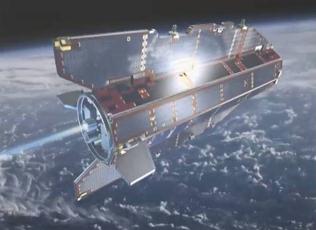After a successful launch from the Plesetsk Cosmodrome in northern Russia by a Rockot launch vehicle, GOCE has to go through a number of preparation stages before becoming operational and starting to collect three-dimensional gravity data all over the globe.
On April 6, 2009, the GOCE’s propulsion system was switched on. The system was confirmed to be operating normally. Two days later, on April 8, 2009, the gradiometer was switched on as well. The instrument started to produce data instantly.
“With the ion engine and the gradiometer working, we have started to tune the satellite and its instruments,” GOCE System Manager Michael Fehringer said.
The payload, an Electrostatic Gravity Gradiometer, consists of six accelerometers mounted in pairs on three perpendicular axes on an ultra-stable carbon-carbon structure. Measurements of the tiny differences in the readings from the accelerometer pairs will render very accurate results for the geoid altitude and the detection of gravity-field anomalies.
Given the unique payload onboard the spacecraft, GOCE has to provide an undisturbed environment for the instruments. Two additional accelerometers mounted on the velocity axes will control the two low-power xenon ion engines in order to compensate for the atmospheric drag. The ion engines each can provide only 1 to 20 milli-Newtons of thrust, which does not sound like very much, but it is enough to overcome the drag experienced by the spacecraft in orbit.
GOCE has been losing altitude at a rate of 150m to 200m a day, until May 26, 2009, when the spacecraft entered the drag-free mode.
Rune Floberghagen, ESA’s GOCE Mission Manager, stated that, “Knowing that the drag-free control system works perfectly means we now have everything in place to carry out the complex process of calibrating the gradiometer instrument. Once calibration has been completed we will be able to see the true excellence of GOCE’s gravity-field measurements.”
The instruments have to undergo a further six weeks of commissioning and calibration. Mission operations are scheduled to start in summer 2009.
You can read more about the GOCE mission on the dedicated page on ESA’s web site.










 Subscribe to our RSS feed
Subscribe to our RSS feed











There are no comments.
Add A Comment